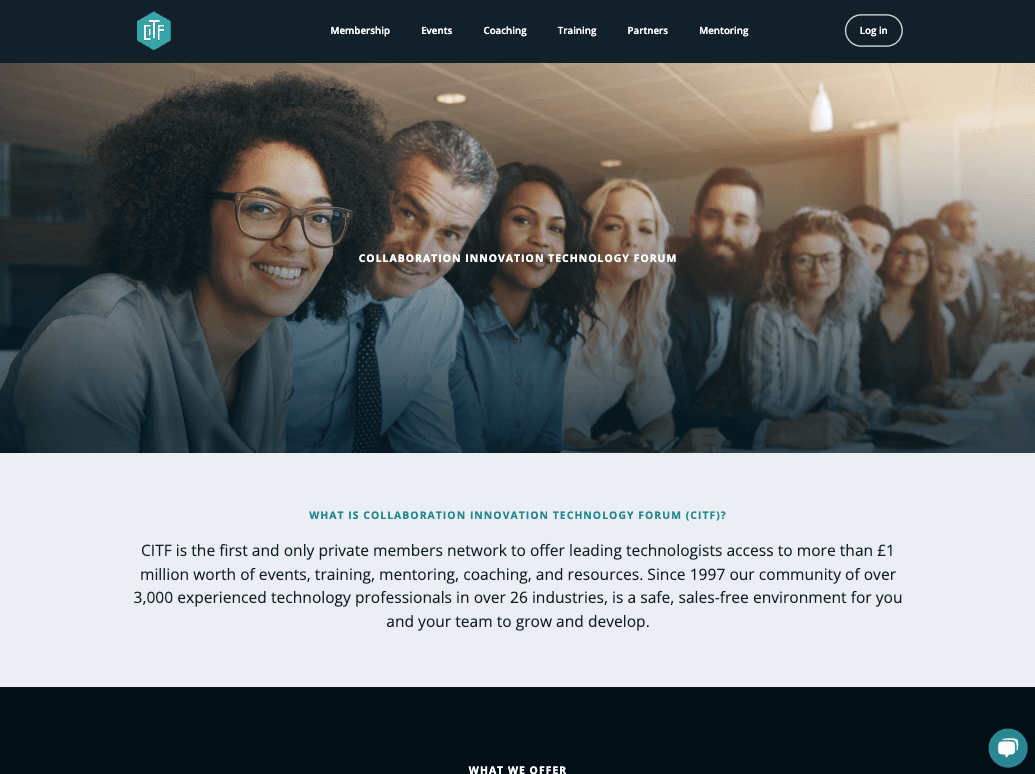How Cygnet developed a Headless SFCC Storefront on Storyblok for CITF.
Moving from monolith to Headless, opening up endless UX and UI possibilities...
The Challenge:
CITF Tech stands as the premier network for technology professionals, providing training, mentorship, and events that promote individual and collective advancement. With a wealth of knowledge from over 3,000 experts across 26 sectors and two decades of experience, CITF includes industry leaders from the financial and governmental sectors.
Previously a Drupal website had been built to promote CITF’s brand to members, however the ‘End of Life’ cycle for Drupal fast approached, ending ongoing product support. As a result, CITF started to assess their stack and evaluate how best to serve their members and customers going forward on a new system.
The complexity of changes to content and pages had become a challenge for editors and users, resulting in a lack of content updates. Whilst editors struggled to make the changes, member data and functionality was fragmented across different systems, creating a challenge for the internal teams to manage at scale.
The convergence of these elements presented an opportune moment for Cygnet to conduct an independent analysis of the UI and on-site performance. With an emphasis on; streamlining content modifications and updates, enhancing side page speeds and load times and undertaking a comprehensive revamp of the CRM system and member portal. Our ultimate goal was to seamlessly integrate these systems, aiming to significantly lessen the internal workload.
The Process:
CITF engaged Cygnet to perform a comprehensive analysis of their tools, systems, and processes, with a particular focus on Web Technology and CRM selection, as this was crucial for the rebranding initiative. A key part of this process was understanding CITF's primary objectives, including the need to efficiently extract event data from the CRM while ensuring the secure and compliant storage of member information site-wide.
Cygnet thoroughly explored critical issues such as content updates, web page design, and the management of fragmented member data. A detailed market analysis was conducted to identify effective solutions for these challenges. This evaluation encompassed a variety of products and platforms, ranging from specialised tools to extensive enterprise systems, all chosen to meet CITF's specific requirements.
Following this assessment, Cygnet recommended a strategic, phased approach, embracing a 'best of breed' strategy for the project. In addition to technology considerations, the choice of partners was crucial, choosing to collaborate with a highly talented independent designer, renowned for expertise in complex rebranding projects, was critical to project success.
The Solution:
Cygnet conducted a thorough analysis of various CRM and Vendor APIs, meticulously choosing the most effective technology stack for CITF. Dedicated to adopting a 'best of breed' strategy, the team collaborated with an independent design consultant to achieve the best client outcome.

Once the designs were finalised, the development phase followed, focused on building out components and pages per the approved designs, translating the conceptual plans into the visual architecture of the website.
The development stage seamlessly fed into the CRM selection process, with Salesforce Marketing Cloud standing out as the preferred choice. After choosing the CRM, Cygnet advanced to the project's second phase, centred around implementing and integrating event data from the Marketing Cloud.. The integration was made possible through creation of a custom API connector, which massively simplified the management of marketing events and member data for the team.
“Working with Cygnet to reevaluate our brand, website structure, and CRM setup was a game-changer. It completely transformed how we appear online and made a huge difference in what we can offer our members. Now, our teams can update content and push for growth easily, without getting tangled up in those long, complicated processes we used to face.” - Joanna Poplawska

Cygnet had constructed a Next.Js headless web-app, based on bespoke designs and branding guidelines. With Frontend infrastructure integrated natively with Salesforce Marketing cloud, facilitating the push of new Member data from the “contact-us' form into CRM automatically, this reduced workload for CITF’s teams, whilst increasing bandwidth for other critical tasks. The Storyblok CMS offered CITF new branding flexibility for content changes and site design. This ensured expansion for pages and content was possible for users, without inhibitive upfront consulting costs or writing complex code.
The result was a new Headless build that allowed for easy content changes that could be built on and scaled at low cost in house, allowing editors to create new pages and initiatives without complex steps to publish, and reducing ownership cost.
Benefits of a headless CMS:
Omnichannel content delivery
Instead of implementing multiple, parallel content management system instances, e.g., to support web and mobile channels, a single headless CMS instance can serve unlimited digital channels.
Better for content editors
The separation of code and content in a headless CMS makes life easier for content editors, who can ignore the code and exclusively focus on the content they are responsible for.
Composable modular content and assets
A single content source, such as a product description for an online catalogue, can automatically adapt to its publishing environment and present itself optimally for its destination.
Open up a world of possibilities, get in touch and find out how we can help you today.
Talk to us about your next project
Get in touch and we'll schedule a scoping call.
